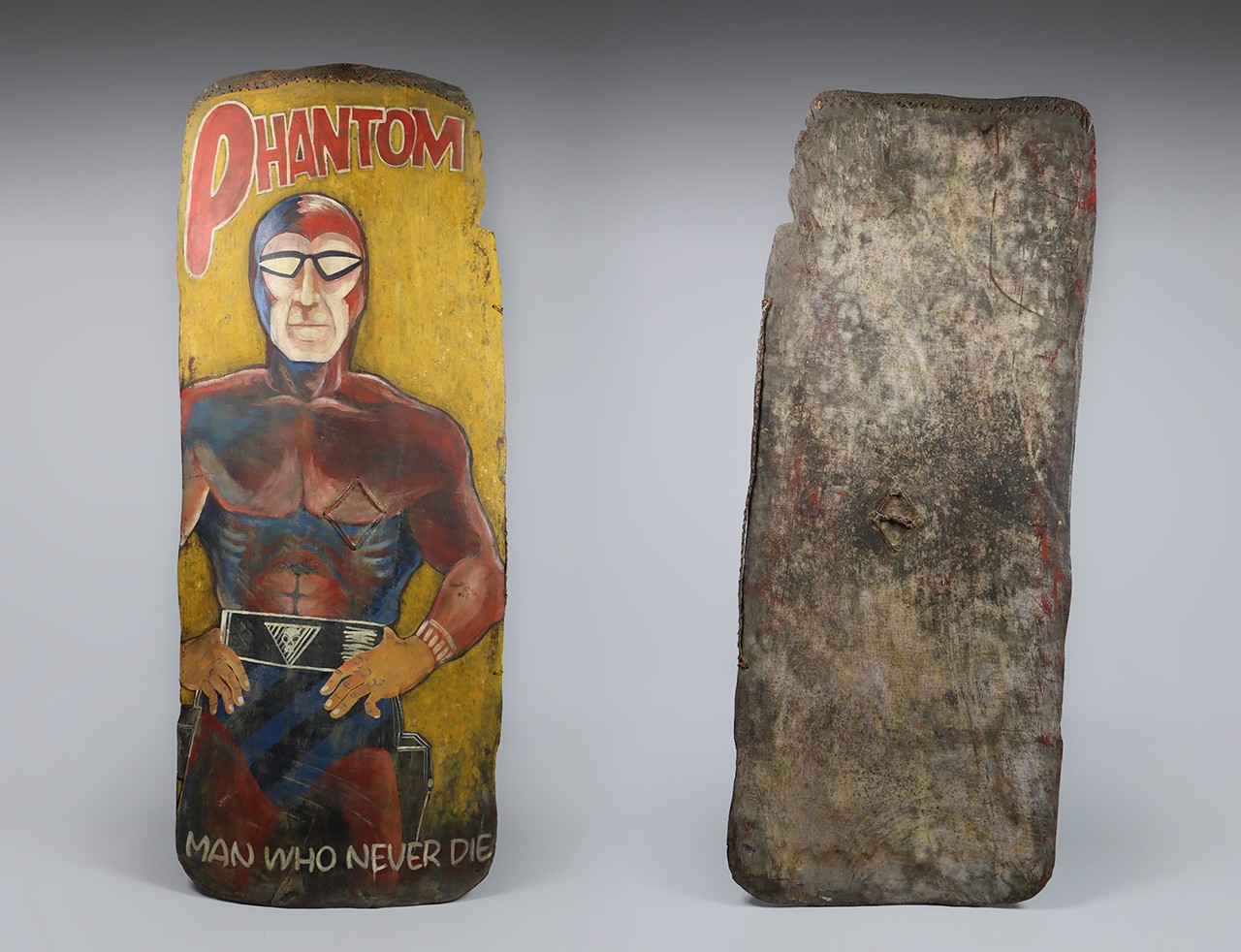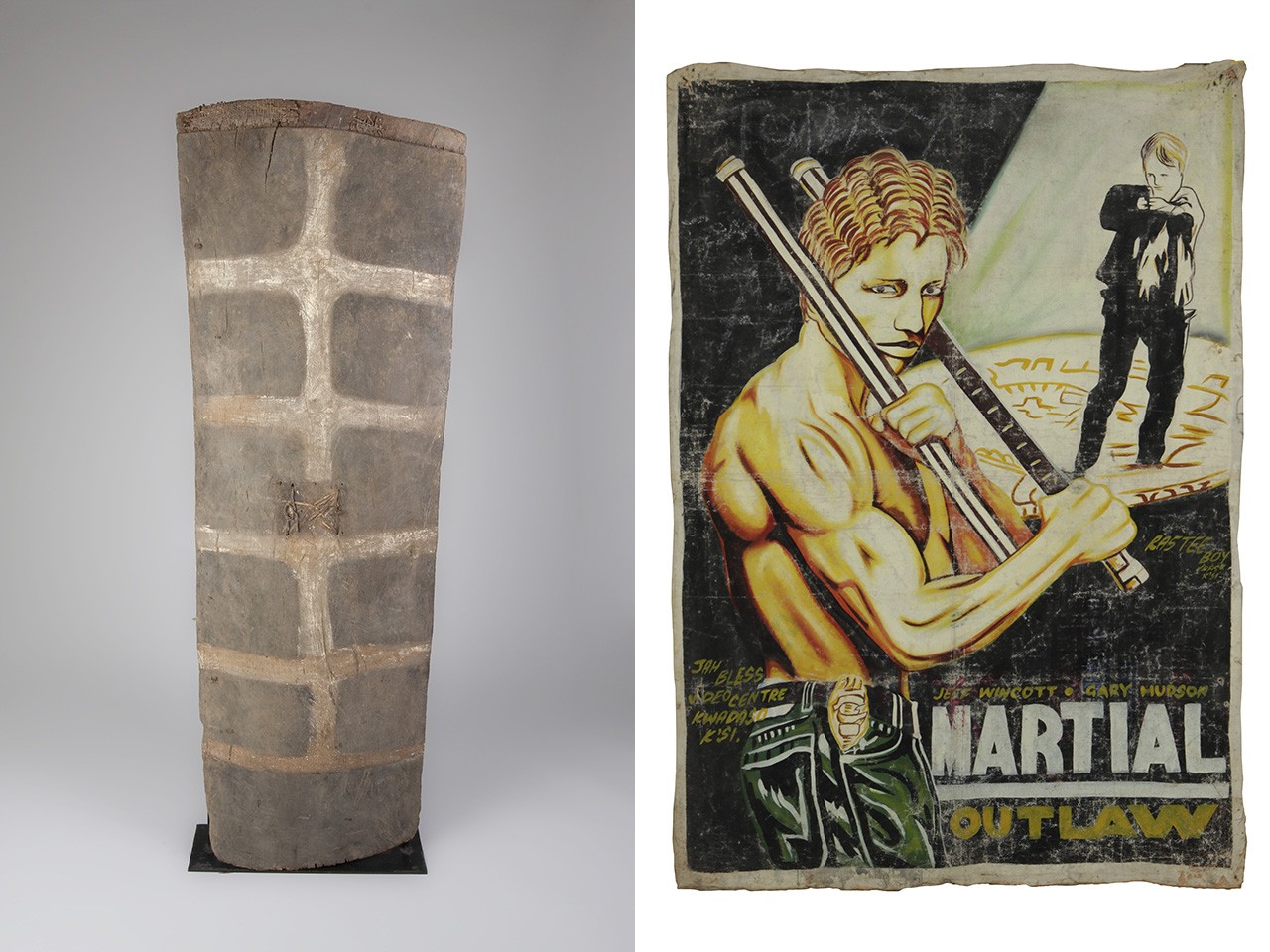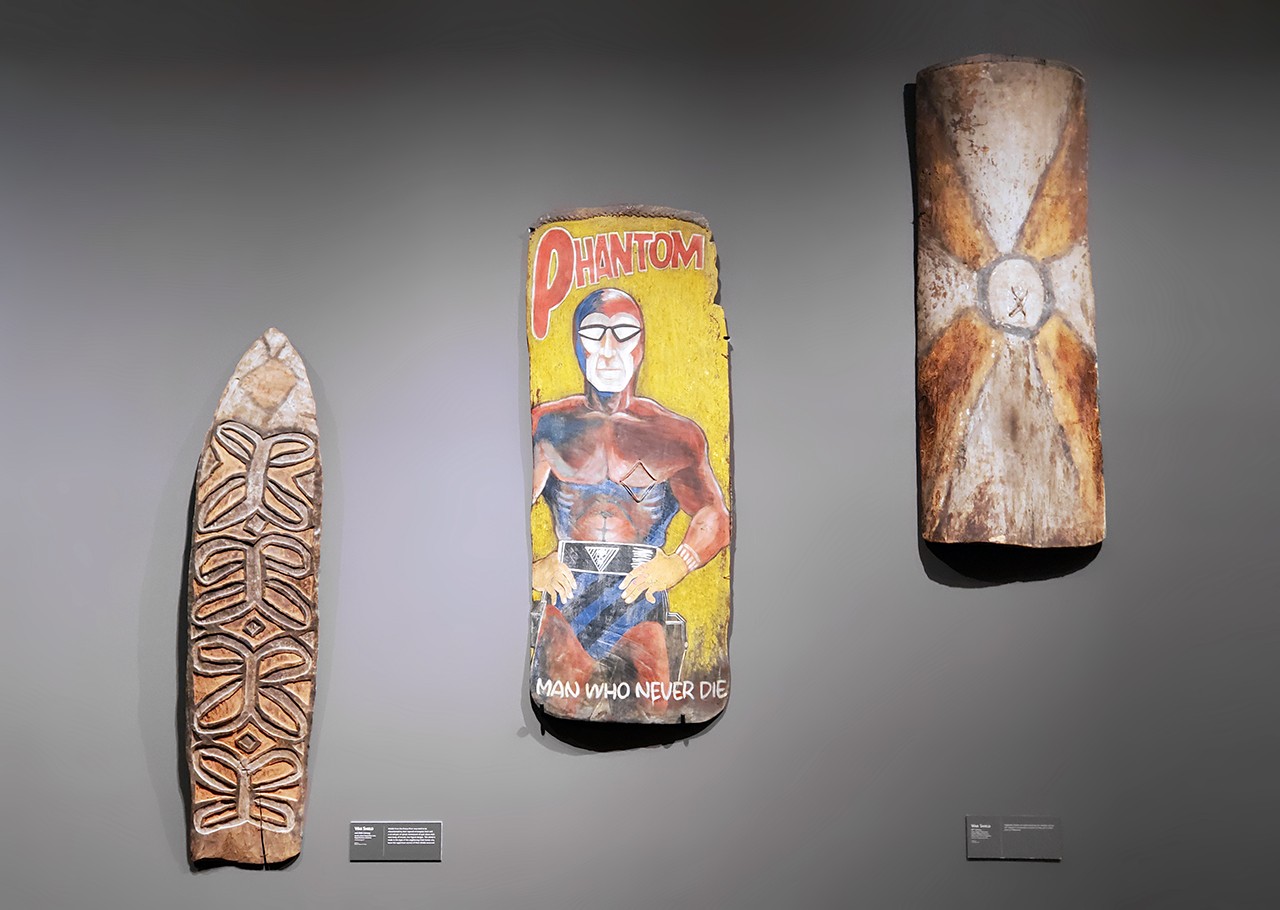 |
Detail of Phantom War Shield, late 20th Century
Wahgi Valley, probably Jiwaka Province, Papua New Guinea, Melanesia
Wood, rattan and commercial paint
2022.10.1
Bowers Museum Purchase in Memory of Dr. Peter C. Keller |
The Ghost Who Walks
This past week the Bowers installed a new acquisition in Spirits and Headhunters: Art of the Pacific Islands that might otherwise look out of place among the geometric and abstracted designs of the exhibition’s Art of Warfare section. It is a traditional war shield from the New Guinea Highlands painted with the Phantom, a comic book character created by the American cartoonist Lee Falk. In today’s post we look at the Phantom: the history of the strip, his introduction to New Guinea, and his appearance in Highlands shields in the 1980s.
 |
2022.10.1
Bowers Museum Purchase in Memory of Dr. Peter C. Keller |
Origin Story
The Phantom has ebbed in popularity to the degree that they might no longer be a household name, but the character’s biggest claim to fame was that they are arguably the first costumed hero—certainly the first to wear tights—to appear in comics. Originally released in February 1936, the strip predates Superman by two years. The premise is that in the 16th century a British boy’s father is killed by pirates off the coast of the fictional African country of Bangalla. Rather than return home, he stays and becomes the first Phantom. The protagonist, “the man who cannot die,” is the 21st in this line to don the identity of the Phantom and fight for Bangalla as justice’s paragon. Armed with akimbo Colt .45 pistols and trustworthy animal companions, the Phantom has battled villains from rising tyrants to the Ku Klux Klan.
 |
The Phantom in Tok Pisin as it appeared in the September 19, 1973 edition of Wantok
From the collection of the Museum of New Zealand |
The Mysterious Ambassador
Almost from its inception, Lee Falk’s strip had an international audience. The Australian Woman’s Mirror first picked up the strip the same year it was created. By the start of World War II, it purportedly appeared in over a thousand newspapers around the world and has since come to be an “institution in Australia, New Zealand and much of Scandinavia.” Coming to New Guinea by way of its Australian administrator, between 1973 and 1977 the strip was translated into Tok Pisin—the mostly widely used language in the country—and published in Wantok, a weekly Catholic periodical distributed to thousands. As a superhero who fights evil doers, venerates his ancestors, and protects a fictional state that at the time bore a great many similarities to Melanesia’s largest island, the Phantom quickly caught on as a national icon.
 |
Traditional War Shield, early 20th Century
Jimi Valley, Jiwaka Province, Papua New Guinea, Melanesia
Wood, paint, rattan, leather, cloth, metal and fiber; 65 3/4 × 23 7/8 × 4 in.
99.76.150
Anonymous Gift |
Martial Outlaw Poster, c. 1995
Rastee Boy (Ghanaian)
Oil on flour sack; 44 × 22 in.
2014.28.14
Gift of Jay and Helen Lavely |
As Reflected in Shields
The popularity of the Phantom in Papua New Guinea led to his appearance outside of comics. In the 1970s the costumed hero became a spokesperson in government advertisements for healthy eating. Around ten years later a period of intertribal war broke out in the Western Highlands Province which lasted into the ‘90s. Though guns were used in some areas and made shields ineffective, in many other regions only traditional weapons were used. Shields that had officially been outlawed by Australian authorities in the 1930s again saw a resurgence, as did the traditional practice of painting designs on shields to intimidate would-be opponents and grant the wielder the strength of what was being depicted. Now though, rather than rely on traditional geometric and abstracted ancestor forms, old shields were repainted with the Phantom. This particular composition with a yellow ground, red lettering, an emphasis on musculature, and slightly distorted proportions is characteristic of Kaipel Ka, a sign painter from the Banz township who painted shields during and after the period of intertribal warfare. Interestingly, portrayals of the Phantom on Highlands shields are strikingly similar in execution to a group of Ghanaian film posters in the Bowers’ collections which were made thousands of miles away during roughly the same period.
 |
2022.10.1 on display in Spirits and Headhunters
Bowers Museum Purchase in Memory of Dr. Peter C. Keller |
The Man Who Cannot Die
The Phantom has been on the mind of this writer quite a bit this past month. Early November 2022 was marred by the unexpected passing of Peter Keller, the Bowers’ President for the past 31 years. There are hardly words for it except to say that is was a devastating loss for the museum. He raised the Bowers to an international stage, doing more for Santa Ana’s oldest museum than perhaps anyone else in our history.
Peter did not do much to conceal that Spirits and Headhunters was his favorite exhibition. Starting in the late ‘90s he went on no fewer than ten expeditions to New Guinea, meeting with local cultures and collecting the world class selection of objects currently on display. Over his many years in New Guinea, a Highlands shield painted with the Phantom—a perfect synthesis of the developing island’s traditional and modern elements distilled during an important transitional period in the island’s history—had eluded Peter. So, during our most recent renovation of the gallery he made the decision to purchase the subject of this post. It is the final acquisition that Peter made on behalf of the Bowers. He never had the chance to see it on display at the museum, but one can imagine he would be very pleased with how it turned out.
The Phantom may not have super strength or heat vision, but he is capable of superhuman feats through his indomitable character. He is known as “the man who cannot die” not because he is immortal, but because his mantle will be taken up by his successors, his family. All of this and more is true of Peter. Like the Phantom, he could be everywhere at once, was uncompromising when it came to his ideals, and pushed others to go further than they had thought themselves capable. Energized by some limitless power source, he was always ready to roll up his sleeves and do what needed to be done. The two even shared in having faithful hounds. Peter spent his life in the pursuit of an invincible legacy and even before his passing had succeeded in creating one. He lives on in the Bowers Museum itself and in all of us who were fortunate to know him, who respect what he accomplished, and who will forever hold him in our minds and hearts as a great man.
Text and images may be under copyright. Please contact Collection Department for permission to use. References are available on request. Information subject to change upon further research.






Comments 2
Well told.
Thanks for an interesting, informative blog post and a nice tribute to Peter, who leaves a great legacy at the Bowers!